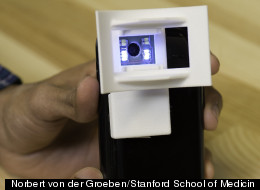Source: www.huffingtonpost.com
Author: staff
The newest tool for diagnosing oral cancer? It might be your smartphone.
Researchers from Stanford University have developed a smartphone app and attachable scanner that its creators hope can improve early diagnoses of oral cancers in places where dental checkups aren’t easily accessible.
OScan is a pack-of-gum-sized device that attaches onto a smartphone camera, that includes a mouth positioner, two rows of light diodes and a circuit board. The tool can take a panoramic photo of the inside of someone’s mouth.
The image is detailed enough that a dental professional would be able to screen for oral lesions, the researchers said.
The device is still being tested, but it has won two awards from the Vodaphone Americas Foundation this week. The creator, Manu Prakash, Ph.D., an assistant bioengineering professor at Stanford, said that he came up with the idea for the device when he was in India at a rural clinic, and saw photos of people with oral lesions — but the lesions were so bad, many were inoperable.
“Sometimes I see a problem and it just sticks in my head. This was one of those moments for me,” Prakash said in a statement. “I just could not walk away from that chance meeting. I knew friends at high school who used to chew tobacco constantly. Nobody talked about the dire consequences.”
The Atlantic explained why this sort of screening tool has the potential to be valuable in countries such as India:
“Like many forms of cancer, oral cancer is easily treated if it’s caught early — but effective screening simply isn’t available to many ordinary Indians. In rural parts of the country, there’s only one dentist available for every 250,000 individuals.”
This is certainly not the first time smartphones have shown promise against cancer and other diseases. Korean researchers published a study in the journal Angewandte Chemie that shows how smartphone touchscreens could also be used to “detect biomolecular matter, much as is done in medical tests,” Reuters reported.
Reuters explained how the technology works:
“The touch screens on smartphones, PDAs or other electronic devices work by sensing the electronic charges from the user’s body on the screen. Biochemicals such as proteins and DNA molecules also carry specific electronic charges.”


Leave A Comment
You must be logged in to post a comment.